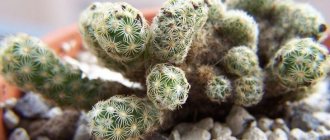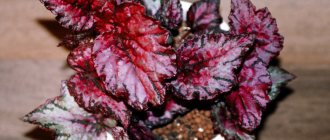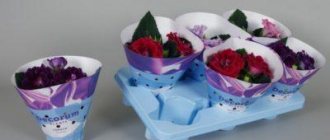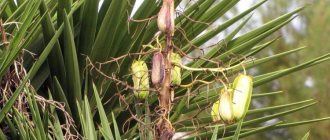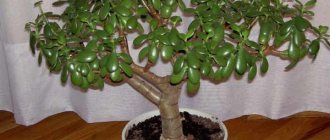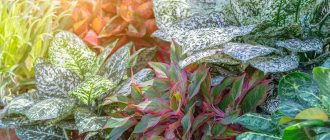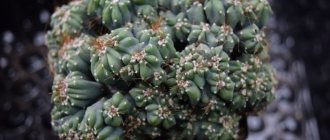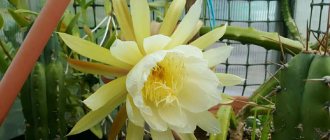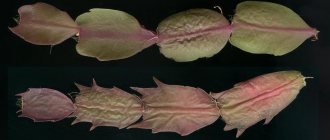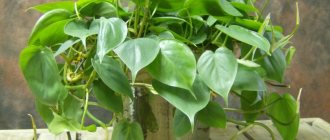The cactus family includes many plants that surprise not only with their beauty, but also with their shape. Forest cacti are especially different from other representatives in their appearance. The genus of these plants includes about 65 species of epiphytes. They are characterized by different shapes of shoots: ribbed, leaf-shaped, cylindrical, etc. These small epiphytic shrubs can reach 1 m. A feature of the plants is the presence of aerial roots.
Forest cacti often grow on trees. In this case, they receive nutrients from organic residues that accumulate on the bark. Plants obtain moisture from the air, absorbing it through the surface of the leaves.
Forest cacti can also actively germinate in small amounts of humus, in rock crevices. Plant roots can attach themselves to rocks.
The natural habitat for these cacti is the tropics of Central and South America. But many of us know these plants as indoor plants.
Features and description
Representatives of this species were discovered for the first time in the forest zone of the South American continent. They grew on trees in the form of green leafy growths. These are epiphytes - plants belonging to the genus Cactus, characterized by a brown-green or green color. They often lack spines.
The most attractive thing about epiphytic cacti is their flowers. They bloom in spring and summer. The buds of these plants are characterized by a wide palette of shades (pink, white, yellow, crimson, etc.). The shape of the inflorescences is also different; they can be both small and large.
Epiphytes are often used in hanging gardening. They make a great home decoration. Leaves of plants with blossoming buds hang attractively and gracefully from the flower pots. These flowers are not only an excellent decoration for the home, they purify the air well. Bioenergetics experts also talk about the positive effect of plants on normalizing the energy balance in a room.
Disocactus
The genus Disocactus (obsolete Aporocactus) belongs to the plant tribe Hylocereeae and grows as forest leaf cacti - epiphytes (on trees) or lithophytes (on rock formations). Native to parts of Mexico, Central America and the Caribbean, this plant is a challenge for the experienced gardener.
Growing Disocactus species can be challenging, but once you learn how to care for your succulent when your plant reaches maturity, you'll enjoy the magic of these fragrant, night-time bloomers. Flowers are formed along the entire length of the stems or at the growing ends of the cacti (depending on the species).
Disocactus flagelliformis
Disocactus or Aporocactus whip-shaped has a rounded stem structure, with thick and hanging stems reaching a length of 1 m, and almost 2 cm in width.
These bright green stems are covered with clusters of indistinct tufts of needles, each composed of thin orange spines. The flowers are large and beautiful, appearing en masse along the stems in late spring - early summer.
Lighting and temperature
The ambient temperature must correspond to the growth phase of the plant. During the rest period, it should not exceed 15-17 0C, at other times the temperature should be within 18-22 0C.
Particular attention should be paid to the lighting of the room. After all, the plant’s natural habitat is the tropics. The light should be diffused but bright. It is necessary to avoid direct sunlight on plant shoots. Experienced gardeners recommend placing flowerpots with home cacti on the east side. Photos of forest cacti will not leave any amateur gardener indifferent. After all, such a plant must be on the windowsill in every apartment.
Care
When caring for forest cacti, you should adhere to several important rules:
- Maintain high humidity levels by spraying.
- Reduce moisturizing in winter to a minimum - 2 times a month. Stop spraying altogether.
- Do not spray cacti during flowering.
- Keep crops in bright, indirect light.
- Transplant annually into a container with a larger diameter by 1–2 cm.
The best place to keep forest cacti is an eastern windowsill. When growing on a north window, additional lighting will be required; on a south window, shading from direct rays of the sun will be required.
In summer, cacti feel good at +20...+30°C. In winter they need coolness. At this time, forest cacti are kept at +15...+18°C. Temperature drops to +10°C and below are dangerous for plants. At the same time as the temperature drops, the amount of watering is also reduced. In cold weather, it is important not to overwater cacti, otherwise they may rot.
In summer, plants need to be watered 2 times a week. The water should be at room temperature, always standing for 1–2 days. Water the plants at the roots.
All cacti, except epiphyllum, must be replanted once a year after flowering. Epiphyllum will bloom only if it grows in a cramped pot.
Cacti do not need frequent feeding. Fertilizers can be applied no more than once a month.
Cactus propagation
Most forest cacti reproduce vegetatively in summer or spring. To do this, you need to carefully cut the cuttings (the top of the stem). You can also use side shoots that already have rudimentary roots.
The sprout must be planted in a small pot in a moist peat-based soil mixture. It is recommended to cover the container with transparent film or a jar to create greenhouse conditions. Within a few weeks, the root system will begin to actively develop.
Difficulties in reproduction are caused by cacti that do not have children. It is necessary to select a healthy side shoot, which is carefully cut with a clean, sterile knife. The cut site is dried for 3-4 days. The cut is sprinkled with a crushed tablet of activated carbon. Afterwards, the cactus can be rooted in a moist substrate, the basis of which will be peat.
Today, flower growers distinguish between many original species and their hybrids. Let's consider the popular names of forest cacti, which can most often be found among amateur gardeners.
Epiphytic cacti of the genus Epiphyllum (Epiphyllum)
There are 19 species in this genus, all of which exist as epiphytes with thick, wide and flattened stems, mostly with wavy, lobed edges. Epiphyllum cacti are characterized by large, impressive flowers. In the last few years, the plants have undergone extensive hybridization to produce a variety of flowers in varying shades.
Epiphyllum is an easy-to-grow and fast-growing genus of succulent that enjoys moist, humus-rich soil and partial shade.
Epiphyllum serrated
The beautiful flowers of Epiphyllum crenatum grow from late spring to early summer. The flower itself is cup-shaped with long, creamy-white inner tepals and pale yellow stamens.
In total, the flower can reach 29 cm in length and up to 20 cm in width, has a strong aroma and is nocturnal, opening at night to attract insects for pollination. The flowers will remain open for several days.
Cactus Epiphyllum acupetallus
Epiphyllum oxypetalum is widely known as the only Epiphyllum species to be widely used for cross-pollination with other genera, such as Disocactus, in an attempt to develop a range of colored hybrids.
Epiphyllum acupetallus
The flower color of Epiphyllum hybrid varieties varies from white to light yellow and orange, and sometimes dark amber hybrids can be found.
Zygocactus
This plant is also known as Schlumberger. This cactus is considered the most common; it is loved for its unpretentiousness and ease of care. The plant is very beautiful, delicate during flowering. The zygocactus leaf consists of many segments with sharp tips. Schlumberger blooms in raspberry, white, pink, and lilac colors.
Diseases, pests and problems in growing epiphyllum
This is not the most resilient of cacti. Epiphyllums often suffer from spider mites, aphids and scale insects. Moreover, aphids love flowering epiphyllums and most of all threaten them when taken out into the fresh air. To protect plants, it is necessary to combine treatment against pests with bio- or conventional insecticides, and adjust the maintenance conditions, increasing humidity and carrying out hygienic procedures.
Of the diseases on epiphyllums, rot is the most common, and only if they are kept in the cold and systemically overflowed. They can only be dealt with by transplanting and removing the damaged parts.
Epiphyllum 'Space Rocket'. © Gary Ashley
Epiphyllum
The name of this cactus is often confused with the general name of the family. But this plant has its own unique history. In the literature, this flower is often called a cactus orchid due to the height of the stem and the splendor of the flowers. All buds are collected in a funnel, which is framed by a large number of pink petals. The stem is cross-shaped, in the recesses of which there are dense leaves.
Epiphytes Hylocereus
The unusual leaf cacti of the genus Hylocereus are among the largest of the epiphytic cacti. These large, climbing semi-epiphytes native to Central and North America have fleshy, articulated stems with aerial roots. They use their roots to cling to trees and shrubs in dry and open forested areas.
Their triangular stems grow to an impressive 5m in length, allowing them to reach a total height of up to 10m. The fruits of the Hylocereus species are completely edible. They contain white pulp studded with hundreds of black seeds. They are also called “dragon fruit”. These exotic-looking fruits are now grown for juice, wine and liquor and eaten fresh in many countries around the world.
Hylocereus wavy or Hylocereus sinuous (Hylocereus undatus)
This ampelous cactus is the most cultivated of all species of the genus Hylocereus. Dark-colored spines grow only on the mature branches of this climbing cactus, and gorgeous flowers bloom at the ends of the branches.
In summer, the ripe buds bloom and a white, bell-shaped flower appears. These powerful and fragrant flowers reach 35 cm in length and up to 30 cm in diameter, opening at dusk for one night only.
Pereskia
This cactus is extremely beautiful when in bloom. The flowers are pale in color and visually resemble a wild rose. The bush itself is small in size. It consists of a large number of stems with dense, glossy, oval-shaped leaves. Pereskia cactus is undemanding to growing conditions and grows well at home with proper care.
Epiphytic cacti of the genus Lepismium
This epiphytic cactus genus Lepismium is native to the lowland tropics and moist montane forests of South America. The culture has about a dozen varieties. Let's look at the two most popular types.
Lepismium cruciform
Lepismium cruciforme is more commonly found in cactus collections consisting of long, twisting succulent stems, each armed with tiny, furry clusters of white spines.
In bright sun, the plant changes color from a natural green shade to a dark pink-burgundy. The stems are very diverse, have a polygonal structure and reach 50 cm in length and 2 cm in width. The flowers are borne along the long, spiny edges of the stem and are quite small and vary in color from creamy white to yellow-pink.
Lepismium floribundum
A recently discovered species with much larger and more fragrant flowers than other members of the genus.
Its dark green, curved and flat stems begin to droop over time, reaching several meters in length. Along the stems are many fragrant, pale pink, bell-shaped flowers. A cold-resistant specimen of a plant with a beautiful bend and a high growth rate.
Conclusion
Forest cacti are plants that have taken root well at home among our compatriots. Everyone knows the Christmas tree that blooms on New Year's holidays. This plant pleases the eye, gives hope and faith in a bright future. After all, in winter, bright cactus flowers help fight depression.
Photos and names of forest cacti will help every novice gardener decide on the future inhabitant of his windowsill. These unpretentious but sophisticated plants will decorate your home and purify the air. A wide variety of types allows you to choose the perfect option for your home.
Popular varieties
Forest cacti are grouped into 65 genera. There are many varieties that differ in appearance and flowering time. Despite significant differences in structure and appearance, these plants prefer the same microclimate. We invite you to get acquainted with five popular varieties of forest cacti that are suitable for home keeping.
Schlumberger
The name of this genus has several more synonyms: zygocactus, epiphyllum, epiphylanthus, Schlumbergera. Its representatives are common in the tropical zone of South America. The genus includes 9 species, 2 of which are actively used in home landscaping. These are Schlumbergera truncata, better known as the Christmas tree or Christmas cactus, and Schlumbergera bridgesii.
In nature, zygocactus grows on the trunks and roots of tropical crops. Since the 19th century it has been introduced into culture.
Zygocactus has several shoots 20–40 cm long, similar to a chain of elongated petals 2–5 cm in size, connected to each other. Flowers that look like lanterns form at the ends of the stems. Their petals can be colored red, yellow, lilac, white, pink. Aerial roots form on the elongated leaves of the plant.
Schlumbergera is most often used for hanging gardening, but it also looks beautiful in tall pots. Christmas tree prefers to grow in nutritious, well-drained, acidic soil in warm, moist conditions. In order for it to bloom, it must be kept at a temperature of +12...+25°C.
Pereskia
Pereskia or Peireskia is the only representative of the subfamily of the same name. The genus is named after the famous French botanist Nicolas-Claude Fabry de Peyresque. It is considered one of the most ancient in the cactus family. Its characteristic feature is the presence of true leaves. The genus includes 17 species. In nature, they are common in the southern regions of North America, most often in forested coastal areas. Some members of the genus have a stem. There are also species that grow as vines. Pereskia's areoles contain straight or curved spines with sharp ends. The cactus blooms with white, creamy yellow, and pink flowers. Depending on the species, they can grow singly or be combined into inflorescences. Pereskia fruits are edible. Residents of Brazil eat them as food, and also eat leaves and inflorescences.
When growing pereskia at home, you need a lot of light, warmth and fresh air. It needs nutritious soil, with a high content of sand and crushed stone. In winter, the plant should be kept cool. Flowering of domestic pereskia occurs rarely.
Rhipsalidopsis
Rhipsalidopsis or Hatiora grows in the tropical forests of Brazil. The genus, according to various sources, unites 5–10 species. Some of them are successfully grown indoors. The bushes of this cactus are compact. The shoots are branching, light green, consist of flat segments 4–6 cm long and 3 cm wide with spines at the ends. Flowers are formed at the ends of the segments. They are shaped like stars. Painted in various colors.
Representatives of the genus Ripsalidopsis are often confused with Christmas trees, but these are different plants and, if you look closely, you can see many differences, for example, in the structure of the shoot segments - Hatiora has smoothed protrusions at the edges, while Zygocactus has sharp teeth. The flowers are also different. In ripsalidopsis they have a smooth corolla, while in Christmas tree they have a slanted corolla. Finally, Rhipsalidopsis blooms in the spring, and Schlumbergera produces buds in December.
In order for representatives of the described genus to feel comfortable at home and produce abundant flowering, they must be kept at a temperature of +18...+20°C in summer, and at +10...12°C in winter. Plants grow well in high humidity, bright indirect light, and in light, slightly acidic soil.
Epiphyllum
Another interesting genus of epiphytic cacti, uniting 20 species. Its representatives attract attention with their unusual structure - the stems of the plants are similar to leaves, and flowers are formed at their ends. The stems are long, branching, droop down, and have aerial roots. There are varieties with flat and triangular stems. Epiphyllum blooms in spring and summer. Its flowers are large - they can reach 40 cm in length.
When planted in the house, epiphyllum looks beautiful as an hanging plant. For it, loose sandy soil and good lighting are selected. The temperature required is moderate, cool in winter.
Epiphyllum is also known as phyllocactus and phyllocereus.
Melocactus
Representatives of the genus Melocactus differ significantly from the cacti described above. Firstly, they have spines, and secondly, they are not epiphytes. There are 4 species found in the forests: Melocactus neryi, M. smithii, M. estevesii and M. mazelianus. They grow in the humid areas of Brazil, Guatemala, and Venezuela. Other members of the genus grow in arid regions. There is an opinion that melocacti were the first cacti that Europeans met when they arrived in South America. They began to be grown in England in the 15th century. Carl Linnaeus described melocacti in the 18th century. They are often called melon cacti.
The plants have a ribbed stem with oval, pubescent areoles. In nature, they can reach 1 m in height, but in indoor conditions they can be much lower. The trunk diameter is 10–20 cm. It is covered with hard spines. A cephalium forms at the top of the trunk. Flowers form in its areoles. They can be crimson, purple-pink, red, purple.
It is believed that melocactus, unlike its close relatives, is capricious when grown indoors. It needs bright lighting, shading from aggressive sunlight, a temperature of +10...+15°C in winter and +30°C in summer, and high humidity.
Features of transplantation: from soil selection to step-by-step process
Decembrist is replanted at the end of February, after it has flowered. During the dormant period, the plant will safely settle into the new pot, and the growth time (these are the summer months) will be used to good effect. Replant young zygocacti every year, adult Decembrists after four to five years.
Pay attention to choosing a pot for your cactus. The material doesn't really matter. But the form is important. A container that is 2–3 cm wider than the old pot and not too deep is suitable. The roots of an epiphytic plant develop not in depth, but in breadth, along the surface.
Young zygocacti are transplanted annually
Zygocactus will like the substrate to be airy and light, slightly acidic . It can be a mixture of turf and leaf soil, peat and sand. Add brick chips or small expanded clay there. Coal powder will make the substrate even lighter and disinfect it. If you don’t want to make the soil mixture yourself, buy special soil for forest cacti in the store.
Decembrist transplant is a simple procedure. Just be careful, cactus segments break off easily. And if some branch breaks off, this is a good reason to start propagating the plant (more on this below). For now we will transplant the Decembrist.
- Take a pot of suitable size.
- Place drainage materials at the bottom: expanded clay, broken brick, pebbles. The drainage layer should fill a third of the pot.
- Place some new substrate on top of the drainage.
- Carefully remove the plant from the old container. If it does not give in, loosen the soil from the edges. You should not water the day before transplanting.
- Lightly shake off the old soil, keeping most of the soil ball.
- Inspect the roots, remove those that are dry or rotten.
- Place the plant in a new pot, distribute the roots and add a little soil. Firm it down slightly as the pot fills. There is no need to tamp with force, as this can damage the roots. In addition, the Decembrist prefers loose soil.
- After planting, water and spray the plant and care according to the period.
According to experts, the transplant has a beneficial effect on the health of the Decembrist. After relocation, its root system and stems are strengthened, as a result it blooms more profusely.
Diseases and pests, methods of control
Unlike many capricious plants (Azalea, Indoor cypress, Vanda orchid, Begonia, Pachistachis, Stephanotis liana), the forest rhipsalis cactus rarely gets sick and copes well with pest attacks. If a florist properly cares for an exotic species, then problems rarely arise.
The previous section describes in detail the care errors against which rot develops. It is important to use not only folk remedies (soap solution, decoction of tobacco leaves, garlic tincture), but also fungicides that destroy the fungus. Be sure to change the conditions of detention and adhere to the rules of moistening the greenery and substrate.
Sometimes rhipsalis is attacked by pests:
- scale insects;
- mealybug.
The fleshy shoots of the forest cactus contain many nutrients that attract parasitic insects. It is dangerous that female scale insects firmly adhere to the surface of fragile shoots and actively drink juices, which can lead to depletion and death of the plant.
How to deal with mealybugs and scale insects? An integrated approach is used:
- treatment with soap solution;
- removal of pests attached to shoots. It is important to act carefully: the segments are fragile, elements are easy to damage;
- spray the plant with an insecticide. To destroy parasites, the compositions Fitoverm, Aktellik, Aktara are used;
- It is necessary to treat not only the stems, but also the soil: pest larvae often hide there.
When using chemical means to combat harmful insects, use a respirator, hand gloves, a medical mask, a headscarf or cap, and wear long sleeves. Violation of basic safety rules when working with synthetic drugs can lead to intoxication. For the same reason, the procedure is carried out in a ventilated room, preferably on a balcony, so as not to take the capricious plant outside, and household members do not inhale particles of the drug.
Reviews from flower growers
I love this flower for its bright pink-raspberry star buds. Each time the flowering occurs on New Year's Eve, and also in the middle of summer, it seems. The plant loves water very much and does not tolerate bright light and heat at all. Only there are problems with the shoots - they don’t take root.
AquaMarinka
https://smoldacha.ru/forum/komnatnoe_cvetovodstvo/topic_27
It’s not for nothing that I called Decembrist the flower of winter. It begins to form buds at the end of November, and in December, when it is already winter outside, the Decembrist begins to bloom on your windowsill. How beautiful it is. I have a pink and white Decembrist growing. This is an unpretentious and grateful flower. Don’t forget to water it and don’t move or touch it during flowering, it doesn’t like it, it starts to drop its buds, and then your Decembrist will delight you with its beauty from December to March. Now March is approaching, and my Decembrists have begun to put on buds again. I think it will still bloom throughout March. By the way, he is not afraid of the heat either. I’m on the sunny side, but he withstands this heat as if nothing had happened. And he doesn’t get capricious when I open the window for a long time in winter. Nothing matters to him. A real Decembrist!
Elena
https://www.imho24.ru/recommendation/44738/
Remember this wonderful song? Do you want to see how flowers bloom in November, when the first frosts have gripped the ground and the white shine of the morning frost outside the window leaves no chance for greenery? The Decembrist flower on the window is just what you need in this grey-white hazy time!
Lens
https://irecommend.ru/content/dekabrist?new=1
Decembrist can have pink and carmine-red and purple flowers. And it usually blooms after stress, if it was cool, if it was not watered for a long time and it was dry, and there are also varieties according to flowering periods: winter and summer. It bloomed beautifully. You can’t touch it, move it or turn it during flowering; it will immediately drop its buds.
Okluba
https://www.forumhouse.ru/threads/53931/page-4
Growing conditions at home (table)
Zygocactus is an unusual succulent. This plant loves water rather than light. Therefore, it will even live near a north window, but not next to heating appliances. This cactus is an epiphyte and needs air with high humidity. And in summer, the plant feels great outdoors, so it is best to take it out into the garden or onto the balcony. What other conditions does the Decembrist require? About this - in the table.
| Period | Lighting | Temperature | Humidity |
| Late winter/spring | The lighting is bright, diffused, light shadow is possible. Windows facing east and west, north-east and north-west are suitable. | +12–15 oC | Moderate humidity, rare watering. |
| Summer | Partial shade with dim diffused lighting. Outdoor seating: in the garden or on the balcony. | +17–22 оC | High humidity, abundant watering and spraying. |
| Autumn | Diffused lighting. Placement on a northeast or northwest window. | +12–15 oC | Moderate humidity, rare watering. |
| Beginning and mid-winter (December, January) | The lighting is diffuse. | +18–22 oC | Humidity 60 percent or higher. Spray with caution, spray only the stems. Water should not get on the flowers. Water abundantly as the soil dries. |
